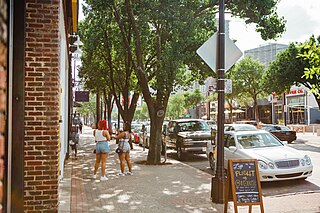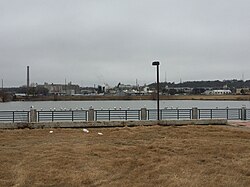
Superfund is a United States federal environmental remediation program established by the Comprehensive Environmental Response, Compensation, and Liability Act of 1980 (CERCLA). The program is administered by the Environmental Protection Agency (EPA). The program is designed to investigate and cleanup sites contaminated with hazardous substances. Sites managed under this program are referred to as Superfund sites. There are 40,000 federal Superfund sites across the country, and approximately 1,300 of those sites have been listed on the National Priorities List (NPL). Sites on the NPL are considered the most highly contaminated and undergo longer-term remedial investigation and remedial action (cleanups).

Deep Ellum is a neighborhood of Dallas, Texas, composed largely of arts and entertainment venues near downtown in East Dallas. Its name is based on a corruption of that of the area's principal thoroughfare, Elm Street. Older alternative uses include Deep Elm and Deep Elem.

Oak Cliff is an area of Dallas, Texas, United States that was formerly a separate town in Dallas County; Dallas annexed Oak Cliff on April 04, 1903. It has since retained a distinct neighborhood identity as one of Dallas' older established neighborhoods.

Oak Lawn is a neighborhood in Dallas, Texas, defined in Dallas City Ordinance 21859 as Planned Development District No. 193, the Oak Lawn Special Purpose District. The unofficial boundaries are Turtle Creek Boulevard, Central Expressway, the City of Highland Park, Inwood Road, and Harry Hines Boulevard. It is over 12 square miles (31 km2) in area. Officially it is bounded by the City of Highland Park, the North Central Expressway, Stemmons Freeway, Woodall Rodgers Freeway, and other roads. The district is within the boundary defined by the City of Dallas law, excluding any existing planned development districts within.

Lake Highlands is a neighborhood constituting most of Northeast Dallas. The neighborhood is a collection of dozens of subdivisions served by Richardson ISD and Dallas ISD public schools, as well as an array of private schools.
Houston Heights is a community in northwest-central Houston, Texas, United States. "The Heights" is often referred to colloquially to describe a larger collection of neighborhoods next to and including the actual Houston Heights. However, Houston Heights has its own history, distinct from Norhill and Woodland Heights.
L.G. Pinkston High School is a public secondary school in West Dallas, Texas (USA). L.G. Pinkston High School enrolls students in grades 7-12 and is a part of the Dallas Independent School District (DISD).
Ledbetter/Eagle Ford is a neighborhood in West Dallas, Texas, United States.
Ledbetter Gardens is a small neighborhood in West Dallas, Texas, United States. Its boundaries are Canada Drive to the north, Bernal Drive to the south, Rupert Street on the east, and Pluto Street on the west. Westmoreland Road, Canada and Bernal Drives are major access points to the neighborhood.
Westmoreland Heights is a small neighborhood in West Dallas, Texas, United States. Its boundaries are Bernal Drive to the north, Singleton Boulevard to the south, Westmoreland Road on the east, and Norwich Lane on the west.
La Bajada is a small neighborhood in West Dallas, Texas, United States. Its boundaries are Canada Drive to the north and east, Sylvan Avenue on the west, and Singleton Boulevard to the south.
Lake West is a neighborhood in West Dallas, Texas, United States. Its boundaries are Canada Drive to the north, the Union Pacific Railroad tracks to the south, Hampton Road on the east, and Westmoreland Road on the west.
Los Altos is a neighborhood in West Dallas, Texas, United States. Its boundaries are Canada Drive to the north, Singleton Boulevard to the south, Sylvan Avenue on the east, and Chihuahua Avenue on the west.
Cadillac Heights is a neighborhood in East Oak Cliff, Dallas, Texas. The neighborhood is mostly African American and Hispanic.
East Dallas, also referred to by the East Dallas Chamber of Commerce as the Lake & Garden District, is an expansive area of numerous communities and neighborhoods in Dallas, Texas, United States that border nearby suburban cities to the east such as Garland, Mesquite and Balch Springs.
South Dallas is an area in Dallas, Texas. It is south of Downtown Dallas, bordered by Trinity River on the west, Interstate 30 on the north, and the Great Trinity Forest to the south and east. In recent years the City of Dallas and organizations including Dallas Area Habitat for Humanity and Rebuilding Together Dallas have begun revitalizing the area in an effort to make the area more attractive to homeowners and foster economic development. This includes high schools- Lincoln High School and James Madison High School.

Downtown Dallas is the central business district (CBD) of Dallas, Texas, United States, located in the geographic center of the city. It is the second-largest business district in the state of Texas. The area termed "Downtown" has traditionally been defined as bounded by the downtown freeway loop, bounded on the east by I-345 (although known and signed as the northern terminus of I-45 and the southern terminus of US 75, on the west by I-35E, on the south by I-30, and on the north by Woodall Rodgers Freeway.

Lakewood Heights is a residential neighborhood in Dallas, Texas (USA), bounded by Abrams Road to the east, Monticello Avenue to the north, Skillman Street to the west, and Richmond Avenue to the south. It located in East Dallas. Lakewood Heights is approximately one-half mile (0.8 km) wide (east-west) and three-quarters of a mile (1.2 km) long (north-south). It covers approximately 240 acres or slightly less than 0.375 square miles (1000m²). It is adjacent to several East Dallas neighborhoods, including Lakewood, Lower Greenville, and Wilshire Heights.
Calumet is the portion of East Chicago, Indiana located east of the Indiana Harbor and Ship Canal and south of Chicago Avenue. The neighborhood is bisected by the Indiana Harbor Belt Railroad. The area west of the tracks is referred to as Calumet proper, or as "West Calumet". The area east of the tracks is known as "East Calumet."
The Dallas–Fort Worth metroplex has 1.2 million African-Americans, the 2nd-largest metro population of African-Americans in Texas.










